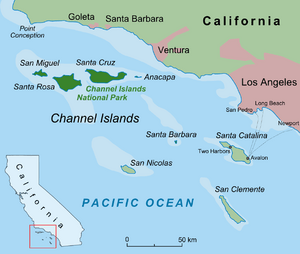Santa Rosae facts for kids

Santa Rosae (also spelled Santarosae) was a very old landmass that existed off the coast of what is now southern California. This was during and after the last ice age. The northern Channel Islands of California are what's left of Santa Rosae today. These islands are near Santa Barbara and Ventura counties.
At its biggest, Santa Rosae was much larger than the northern Channel Islands we see now. It was about 3 to 4 times bigger. It stretched nearly 125 kilometers (77.67 miles) from east to west.
Contents
How Santa Rosae Changed
Between about 20,000 and 5,000 years ago, Santa Rosae lost a lot of its land. About 70% of it went underwater. This happened because sea levels rose after the ice age ended. The huge ice sheets on land melted, and the water flowed into the oceans. This created a large underwater landscape that scientists are still exploring today.
The landmass of Santa Rosae broke up between 11,000 and 9,000 years ago. The sea levels rose by about 100 meters. This is how the islands we know today, like San Miguel, Santa Rosa, Santa Cruz, and Anacapa Island, were formed. These are the parts of Santa Rosae that are still above water.
The Lost Island of Calafia
Scientists think there might have been another island called Calafia. This island is now underwater. It was located between Santa Rosae and the mainland of California.
Ancient Life on Santa Rosae
Santa Rosae was once home to a special type of animal. These were pygmy mammoths, which were much smaller than the mammoths you might imagine. They became extinct about 13,000 years ago.
Early Humans and Their Journey
On Santa Rosa Island, scientists found a very old human skeleton. It is about 13,000 years old and is called Arlington Springs Man. This is one of the oldest human remains ever found in North America.
Since Santa Rosae was not connected to the mainland back then, this discovery is very important. It shows that early people, called Paleo-indians, traveled to the island using boats. This means they had advanced boat-building skills.
These early coastal people were very clever. They fished, hunted sea mammals and birds, and gathered plants from the island. They lived on the island until about 8,000 years ago. These people might be the ancestors of the Island Chumash tribe. The Chumash lived on the northern Channel Islands for thousands of years. Later, in the 1820s, Spanish authorities moved them to missions on the mainland.

